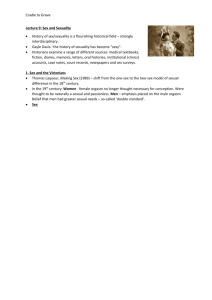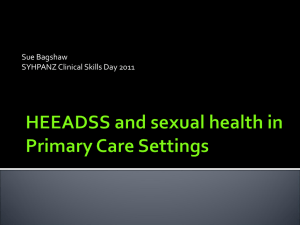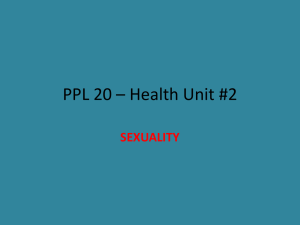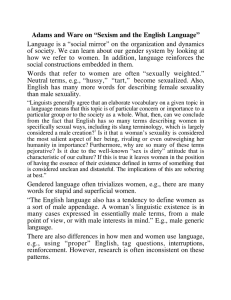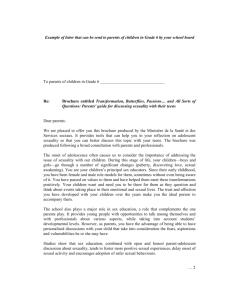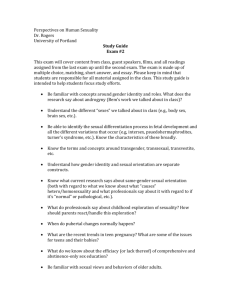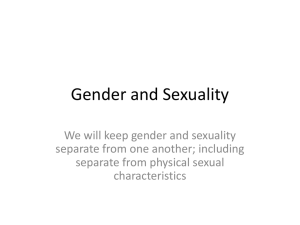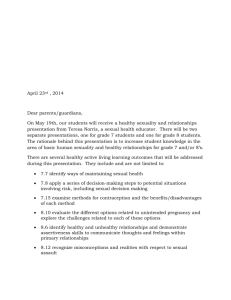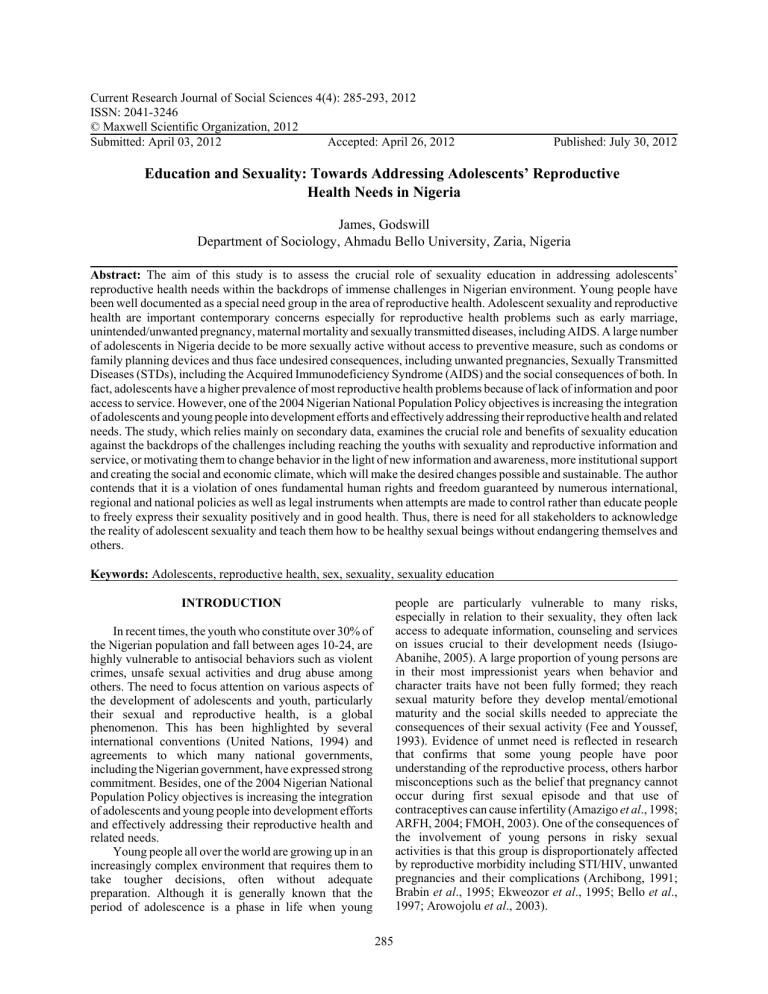
Current Research Journal of Social Sciences 4(4): 285-293, 2012
ISSN: 2041-3246
© Maxwell Scientific Organization, 2012
Submitted: April 03, 2012
Accepted: April 26, 2012
Published: July 30, 2012
Education and Sexuality: Towards Addressing Adolescents’ Reproductive
Health Needs in Nigeria
James, Godswill
Department of Sociology, Ahmadu Bello University, Zaria, Nigeria
Abstract: The aim of this study is to assess the crucial role of sexuality education in addressing adolescents’
reproductive health needs within the backdrops of immense challenges in Nigerian environment. Young people have
been well documented as a special need group in the area of reproductive health. Adolescent sexuality and reproductive
health are important contemporary concerns especially for reproductive health problems such as early marriage,
unintended/unwanted pregnancy, maternal mortality and sexually transmitted diseases, including AIDS. A large number
of adolescents in Nigeria decide to be more sexually active without access to preventive measure, such as condoms or
family planning devices and thus face undesired consequences, including unwanted pregnancies, Sexually Transmitted
Diseases (STDs), including the Acquired Immunodeficiency Syndrome (AIDS) and the social consequences of both. In
fact, adolescents have a higher prevalence of most reproductive health problems because of lack of information and poor
access to service. However, one of the 2004 Nigerian National Population Policy objectives is increasing the integration
of adolescents and young people into development efforts and effectively addressing their reproductive health and related
needs. The study, which relies mainly on secondary data, examines the crucial role and benefits of sexuality education
against the backdrops of the challenges including reaching the youths with sexuality and reproductive information and
service, or motivating them to change behavior in the light of new information and awareness, more institutional support
and creating the social and economic climate, which will make the desired changes possible and sustainable. The author
contends that it is a violation of ones fundamental human rights and freedom guaranteed by numerous international,
regional and national policies as well as legal instruments when attempts are made to control rather than educate people
to freely express their sexuality positively and in good health. Thus, there is need for all stakeholders to acknowledge
the reality of adolescent sexuality and teach them how to be healthy sexual beings without endangering themselves and
others.
Keywords: Adolescents, reproductive health, sex, sexuality, sexuality education
people are particularly vulnerable to many risks,
especially in relation to their sexuality, they often lack
access to adequate information, counseling and services
on issues crucial to their development needs (IsiugoAbanihe, 2005). A large proportion of young persons are
in their most impressionist years when behavior and
character traits have not been fully formed; they reach
sexual maturity before they develop mental/emotional
maturity and the social skills needed to appreciate the
consequences of their sexual activity (Fee and Youssef,
1993). Evidence of unmet need is reflected in research
that confirms that some young people have poor
understanding of the reproductive process, others harbor
misconceptions such as the belief that pregnancy cannot
occur during first sexual episode and that use of
contraceptives can cause infertility (Amazigo et al., 1998;
ARFH, 2004; FMOH, 2003). One of the consequences of
the involvement of young persons in risky sexual
activities is that this group is disproportionately affected
by reproductive morbidity including STI/HIV, unwanted
pregnancies and their complications (Archibong, 1991;
Brabin et al., 1995; Ekweozor et al., 1995; Bello et al.,
1997; Arowojolu et al., 2003).
INTRODUCTION
In recent times, the youth who constitute over 30% of
the Nigerian population and fall between ages 10-24, are
highly vulnerable to antisocial behaviors such as violent
crimes, unsafe sexual activities and drug abuse among
others. The need to focus attention on various aspects of
the development of adolescents and youth, particularly
their sexual and reproductive health, is a global
phenomenon. This has been highlighted by several
international conventions (United Nations, 1994) and
agreements to which many national governments,
including the Nigerian government, have expressed strong
commitment. Besides, one of the 2004 Nigerian National
Population Policy objectives is increasing the integration
of adolescents and young people into development efforts
and effectively addressing their reproductive health and
related needs.
Young people all over the world are growing up in an
increasingly complex environment that requires them to
take tougher decisions, often without adequate
preparation. Although it is generally known that the
period of adolescence is a phase in life when young
285
Curr. Res. J. Soc. Sci., 4(4): 285-293, 2012
With the negative effects of modernization and a
multiplicity of other factors which tend to reduce the
ability of families to effectively educate and take care of
their young ones, there is an urgent need for effective
intervention strategies that will promote the well-being of
young people, foster positive attitudes and healthy
behaviors in adult life. There is need for stakeholders to
provide relevant life skill education to address specific
development problems being faced by young people,
particularly those of sexuality and reproductive health. In
this regard, the introduction and institutionalization of
sexuality education becomes one of the immediate efforts
to address this problem, that is, to create awareness about
this sexually based problem. Therefore, the purpose of
this study is to examine the crucial role of sexuality
education in addressing adolescents’ reproductive health
needs within the backdrops of immense challenges in
Nigerian environment. Although people of all age groups
can benefit from sexuality education, this study pays
particular attention to sexuality education among young
persons in Nigeria. The study justifies the need for
sexuality education in young persons and provides
evidence of the benefits of sexuality education to this
group.
pertains to the totality of being human (a female or male)
and this suggests a multidimensional perspective of the
concept of sexuality which is shaped by biological,
psychological, economic, political, social, cultural and
religious factors operating within the particular context of
young persons in each society.
It also underscores the need to understand that
sexuality education addresses a wide range of needs and
is meant for all persons since its purpose is to achieve
sexual health, which is not restricted to the act of having
sex, but refers to “a state of physical, emotional, mental
and social well being in relation to sexuality and not
merely the absence of disease, dysfunction or infirmity”.
Sexual health requires a positive and respectable approach
to sexuality and sexual relationships, as well as the
possibility of having pleasurable and safe sexual
experiences free from coercion, discrimination and
violence. For sexual health to be attained and maintained
in any social setting, the sexual rights of all persons must
be respected, protected and fulfilled. Sexual rights
necessitate that all persons, irrespective of sex, are free
from coercion, discrimination and violence, to:
C
CONCEPTUAL FRAMEWORK
C
Sexuality is a fundamental concept in the
understanding of sexuality education. Clear understanding
of what sexuality and sexuality education mean is
necessary because there seems to be widespread
misconception that sexuality is all about issues related to
sexual intercourse and on the basis of this misconception
some programs of sexuality education in Nigeria have
faced steep opposition. Therefore, the definition of
sexuality is a necessary step in defining the scope and
content of sexuality education proposed in this study.
According to a report by WHO (2002), sexuality is a
central aspect of being human throughout life and
encompasses sex, gender identities and roles, sexual
orientation, eroticism, pleasure, intimacy and
reproduction. It is often experienced and expressed in
thoughts, fantasies, desires, beliefs, attitudes, values,
behaviors, practices, roles and relationships but not all of
them are experienced or expressed since it is influenced
by the interaction of biological, psychological, social,
economic, political, cultural, ethical, legal, historical,
religious and spiritual factors. It has been described to
mean “the totality of who you are, what you believe, what
you feel and how you respond” (Action Health
Incorporated, 2003) (AHI). Sexuality is often broadly
defined as the social construction of a biological drive,
which often deals with issues such as whom one has sex
with, in what ways, why, under what circumstances and
with what outcomes a person engages in sex National
Aids Control Council (NACC, 2002). Thus, sexuality
C
C
C
C
C
C
C
The highest attainable standard of sexual health,
including access to sexual and reproductive health
care services
Seek, receive and impart information related to
sexuality
Sexuality education
Respect for bodily integrity
Choose their partner
Decide to be sexually active or not
Consensual sexual relations
Consensual marriage
Decide whether or not and when, to have children;
and pursue a satisfying, safe and pleasurable sexual
life (www. who. int/reproductive-health/gender/
sexual_ health.html). The three elements of sexuality,
sexual health and sexual rights are interrelated and
interwoven and one cannot be achieved in the
absence of the other two. So sexuality, simply put, is
the full attainment of sexual health and rights in any
given society.
Sexuality education, on the other hand, has been
defined and approached differently by various schools of
thoughts. Action Health Incorporated (2003) for instance,
describes sexuality education as a “planned process of
education that fosters the acquisition of factual
information, the formation of positive attitudes, beliefs
and values as well as the development of skills to cope
with the biological, psychological, socio-cultural and
spiritual needs of human sexuality.” This implies learning
286
Curr. Res. J. Soc. Sci., 4(4): 285-293, 2012
was found to be an average of 59.4%; whereas knowledge
of symptoms of different types of STIs in men and women
by 15 to 19 year olds ranges from 6.8 to 44.1%. In respect
of knowledge of rights of People Living with HIV/AIDS
(PLWA), 30.6% of the respondents aged 15 to 19 years
believe that the rights of the PLWA are protected in
Nigeria. This is evidence of gross lack of knowledge
about sexuality and reproductive health issues among
young people across the country.
about the anatomy, physiology and bio-chemistry of the
sexual response system which determines identity,
orientations, thoughts and feelings as influenced by
values, beliefs, ethics and moral concerns. The interactive
relationship of these dimensions describes an individual’s
total sexuality (SIECUS, 1995).
Evidently, sexuality education is a lifelong process of
building a strong foundation for sexual health through
acquiring information and forming attitudes, beliefs and
values about identity, relationships and intimacy. The
education whose curricula encompasses sexual
development, reproductive health, interpersonal
relationships, affection, intimacy, body image and gender
roles, takes place on a daily basis in homes, schools, faithbased institutions and through the media. The curriculum
emphasizes knowledge, behavior, attitudes and skills that
promote committed family and healthy relationships, good
character, healthy sexual and reproductive health. A
comprehensive sexuality education program, therefore,
teaches young people knowledge and skills of critical
issues related to sexuality, including puberty and the
reproductive anatomy, emotional aspects of maturation,
value of abstinence among teens who are not sexually
active, alternative methods of contraception and HIV/STD
prevention, health consequences of avoiding
contraceptives, preventive methods among sexually active
youths. These recommendations are supported by Kirby
(2001) who advises that effective sexuality programs:
C
C
C
C
C
Poor access/unmet need: Among the 15 to 19 year olds,
accessibility of different family planning methods was
found to vary from 6 to 19%; and use of condoms was
found to be practiced by a mere 34.4% (FMOH, 2003).
According to Alan Guttmacher Institute (2004), only 4%
of married adolescent women use a modern contraceptive
method, compared with 24% of unmarried sexually active
women of this age. Overall, 17% of adolescent women in
Nigeria, about one-half of whom are unmarried, have an
unmet need for effective contraception; that is, they are
sexually active, are capable of becoming pregnant and do
not want a child soon, but they are not using an effective
contraceptive method.
Early sexual debut/high sexual activity: As in most
parts of the world where premarital sex is rising (PRB,
2000), in Nigeria, by the age of 19 years, 70% of all
Nigerian adolescents have become sexually active and
they often do not employ any means of protection
(Nigeria Demographic and Health Survey, 1999); no
wonder, Nigerian adolescents of ages 15 to 19 years rank
among the highest in level of fertility, with 112 births/
1000 females.
The 2008 NDHS shows that over 15% of women age
15-19 had first sexual intercourse by age 15 and more
than half (56%) of women age 15-49 were sexually active
during the 4 weeks preceding the survey. Similarly, over
12% of women age 15-19 married by age 15. Overall,
23% of women age 15-19 have begun childbearing in
Nigeria; 18% have had a child and 5% are pregnant with
their first child (NPC and ICF Macro, 2009). Although
there was a 27% decline in the birth rate among women
age 15-19 between 1980 and 2003, 46% of women
nationally and about 70% of those in some geo-political
zones still give birth before their 20th birthday (Alan
Guttmacher Institute, 2004; NPC and ORC Macro, 2004).
Include activities that address social pressures
associated with sexual behavior.
Provide modeling and the practice of communication,
negotiation and refusal skills.
Incorporate behavioral goals, teaching methods and
materials that are appropriate to the age, sexual
experience and culture of the students.
Last a sufficient length of time to adequately
complete important activities adequately.
Provide basic, accurate information about the risks of
unprotected intercourse and methods of avoiding
unprotected intercourse.
Adolescents’ reproductive health needs in Nigeria:
There are various types of risks that young people are
exposed to which sexuality education can target and bring
about redress. These include early sexual activity and its
consequences such as unwanted pregnancy, induced
abortion and pregnancy complications as well as Sexually
Transmitted Infections (STI).
Unwanted/unintended pregnancy: There is ample
evidence that much of this early childbearing, whether
within or outside marriage is unwanted. In Nigeria as a
whole, 18% of recent births to adolescent women
(married and unmarried) are unplanned, that is, the mother
would have preferred the birth later or not at all (Alan
Guttmacher Institute, 2004). However, this proportion
reportedly ranges widely by region, from a low of 3%
Poor knowledge: The National HIV/AIDS and
Reproductive Health Survey (NARHS) (FMOH, 2003)
reports poor knowledge of sexuality and reproductive
health issues, especially among young persons of 15 to 19
year old. Knowledge of condom among 15 to 19 year olds
287
Curr. Res. J. Soc. Sci., 4(4): 285-293, 2012
they often do not know where to get them or how to use
them (Agyei and Epema, 1992). Contraceptive methods
are not often used at the first intercourse mainly because
of the belief that a girl cannot become pregnant the first
time she had sex. For instance, Makinwa-Adebusoye
(1991b) reported that 30% of male and female adolescents
sampled in five major urban centers in Nigeria did not
realize that the first intercourse could result in pregnancy,
thus they do not use contraceptive methods to prevent
unwanted pregnancy.
The high rate of unprotected sexual networking
among adolescents in Nigeria increases their risk of
contracting STDs/HIV/AIDS. Since most adolescents are
active sexually but lack adequate knowledge of the risks
involved, they constitute the group that is highly
vulnerable to unwanted pregnancy and HIV/AIDS
pandemic. It should be noted also that STDs including
HIV are rampant in the developing nations including
Nigeria due to lack of education. Most of the adolescents
do not receive family life education and hence, they are
not aware of precautionary measures to adopt in order to
prevent and protect themselves at sexual
relationship/intercourse. Even in the event of getting in
contact with any of these diseases, most adolescents do
not know their symptoms, what to do next, or where else
to go. Instead, they prefer to conceal it until it almost gets
out of hands, or ask for advice from their peers who are
just ignorant as them.
among women in the North-West region to a high of 69%
among those in the South-West region. The proportion
unplanned is also above average in the case of births to
more educated adolescent women in both urban and rural
areas (31 and 44%, respectively).
Unsafe abortion: High rates of unsafe abortion among
adolescent women also attest to the issue of unwanted
pregnancies. Abortion is illegal in Nigeria, but roughly
610,000 abortions are performed in the country each year
(Henshaw, 1998) under unsafe conditions and by
untrained persons, with potentially harmful consequences
for women. In a similar report which was compiled by
International Planned Parenthood Federation (IPPF),
Airiohuodion (1997) cited that abortion complications
accounted for 72% of all deaths of young women under
19 years of age in Nigeria. Some hospital-based studies
conducted in Nigeria, particularly Adewole (1992),
Okonofua (1996) and Adetori (1999), showed that
adolescents make up a disproportionately high proportion
of women treated for abortion complications-between 6175%. This over-representation is likely due to the fact that
compared with their adult counterparts, adolescent women
are less likely to use contraceptives and more likely to
resort to an unsafe abortion. In fact, adolescents are more
likely to turn to traditional healers, chemists, shopkeepers
or other non-medical personnel for abortion, or selfinduce abortion using a variety of unsafe methods,
including drinking quinine, alcohol, detergent or toxic
teas, or swallowing large doses of over-the-counter
substances, such as prostaglandin (Mohamud, 1996).
They are also more likely to seek an abortion later in their
pregnancy and are slower to seek medical help once
complications develop.
The role of sexuality education in improving the
reproductive health status of young persons in
Nigeria: Sexuality education seeks to assist young people
in understanding positive view of sexuality, provide them
with the skills about taking care of their sexual health and
making decisions now and in the future. The rationale is
to acquaint the youth with factual and accurate
information about the dimension of sexual knowledge that
will enable them understand and clarify their personal
values, improve their sexual knowledge and sexual
decision-making and promote their knowledge about how
all these interact with socio-cultural and religious factors
to affect personal wellbeing. Such education enables the
young people to know themselves and hence relate
positively with others. Thus, sexuality education is simply
the art of learning how to conform to a certain art of living
by being able to reason, examine and monitor oneself in
clearly defined terms (Adepoju, 2005). Reasoning or
thinking is the goal of sexuality education programs.
Teenagers certainly need to think before they act in many
aspects of life, but even more in sexual contexts.
Sexuality education may not stop them from having sex,
but it is capable of making teenagers think twice before
having unprotected sex; it not only teaches about positive
sexual attitudes or responsible sexual activities, but also
Adolescents’ vulnerability: Apart from sexual activity,
among boys and girls, gender issues in sexuality and
reproductive health is a major concern for sexuality
education. There is need to highlight the issue of double
vulnerability of girls as they are more exposed to risky
sexual encounters. These include young girls’ exposure to
rape and other forms of sexual violence, which often lead
to sexual dysfunction and involvement in sex with
multiple partners and sex for exchange of money.
Sexuality education on gender issues is far from optional
as the incidence of gender-based violence often associated
with sex seems to be on the increase.
Young people often know little or have incorrect
information about sexuality, fertility and contraception.
Young men are more likely than women to mention lack
of knowledge and are much more likely to say that it is
their partner’s responsibility to avoid pregnancy
(Berganza et al., 1989; Baker and Rich, 1992; Morris,
1992). Even when young people can name contraceptives,
288
Curr. Res. J. Soc. Sci., 4(4): 285-293, 2012
Table 1: Evidence of benefits of sexuality education among students
Author
Target group
Nature of program
Osowole (1998)
physically challenged boys
training of peer educators
and girls
Fawole et al. (1999)
Osowole and
Oladepo (2000)
Ajuwon (2000)
Adegbenro (2004)
high school students
six weekly educational
session by researchers
male high school students
peer education
male and female high
school students
high school students
peer education
peer counseling, teacher
training
Table 2: Evidence of benefits of sexuality education among out-of-school youths in Nigeria
Author
Target
Nature of intervention
Brieger et al. (2001)
out of school youths in
peer education
Ghana & Nigeria
Brieger et al. (2001)
out-of-school youths
community-based
Fawole et al. (2004a, b)
hawkers and female apprentices
general education
C
peer pressure, drugs, relationships and decision-making.
Young people need to be guided to make decisions today
that will create the future they desire rather than the one
they fear.
According to Madunagu (2005), comprehensive
Sexuality Education would guide young people into
having a healthy and responsible sexuality and sexual life.
This is because through Sexuality Education, young
people would be guided:
C
C
C
C
C
C
C
C
Outcome
Increase in discussion on reproductive and
sexual issues
C Reduction in reported cases of unwanted
pregnancy during programme
C Reduction in sexual partners
C
C
C
C
C
C
C
C
C
C
Positive attitude to PLWHA
Increase in use of condom
No effects of use of condoms
Increase in reproductive knowledges
Improve self-efficacy to use condoms
Increase in reproductive health
Improved self-efficacy to use condoms
Increase in knowledge of reproductive
health
Reduction in drop-out rate due to pregnancy
Outcome
C Increase in knowledge of reproductive health
C No effects on sexual behavior
C Increase in knowledge of reproductive health
C Increase in use of condom
C Increase in knowledge of gender-based
violence
C Reduction in prevalence of physical violence
C Improved help-seeking during incidence of
violence
To avoid confusing and misleading information and
negative pressure from peers, older siblings, videos,
blue firms, music, magazines and other media
sources and influences.
To acquire accurate scientific information on basic
sexual and reproductive health, values, decision
making, communication and life management skills.
Furthermore, in an attempt to address the unmet
sexuality education needs of young persons, several
governmental, non-governmental agencies and individuals
have implemented various programs targeting different
categories of young persons including secondary school
students, physically challenged youths, apprentices and
hawkers across the country. A summary of the nature and
outcome of sexuality education programs targeting
students and the out-of-school youths are shown in
Table 1 and 2, respectively. The data were derived from
surveys that were well designed and evaluated. All the
studies cited adopted a design that included experimental
(intervention) groups and comparison (control)
populations. Consequently, the findings are generalized
(Ajuwon, 2005). The data shows that the resources
invested in implementing sexuality education programs
for young persons are worthwhile because such programs
had led to improvement in the reproductive health status
of the young persons who had participated in them.
To express their sexual feelings in ways that are not
harmful to themselves or to another person.
Not to take risk with their feelings and not to take
risk with the feelings of others.
To take time to learn about their life goals and how to
choose careers to meet their goals.
To take time to learn about their emotions and how to
be sexually safe and healthy.
To know about the kinds of sexual practices that
people engage in and hence take time to reflect and
think about their choices and be in charge of such
choices in the best interest of their health.
To be able to postpone the expression of sexual
feelings through sexual intercourse until, they are
ready for the responsibilities of its consequences.
To learn and understand the consequences of
unprotected sex and how best to remain healthy and
free from diseases and infections.
289
Curr. Res. J. Soc. Sci., 4(4): 285-293, 2012
In spite of these gains, there is no denying the fact
that there are some categories of people in Nigeria like in
many African countries, who are opposed to the
introduction of sexuality education. Such groups argue
that the youths do not need sexuality education for it
would lead to more sexual immorality at too early age,
resulting to more teenage pregnancy, back-street abortions
and further spread of HIV/AIDS. There are also some
faith-based groups that argue that knowledge from sex
education could lead to the practice of family planning by
the youths, affecting negatively their sexuality and also
their bodies.
However, it is important to observe that in recent
times parents are too absent from their children and
therefore, no longer counseling them on sexuality as most
of the time the children are in school; our traditional
values and norms are gradually fading because of the
effects of modernization. It would, therefore, not be out of
place to bring sexuality education to the environment of
the child. Moreover, available research on sexuality
education provides evidence that sexuality programs do
not hasten the onset of sexual intercourse, do not increase
the frequency of sexual intercourse and do not increase
the number of partners sexually active teens have;
education about abstinence and contraception are
compatible rather than in conflict with each other and that
making condoms available does not increase sexual
behavior (Kirby, 2001).
To further contradict the opinion that may currently
be held by groups opposed to introduction of sexuality
education in schools, a report by UNAIDS (1997)
examined 68 reports on sexuality education from France,
Mexico, Switzerland, Thailand, the United Kingdom, the
United States and various Nordic countries. The review
found 22 studies that reported that HIV and/or sexual
health education either, delayed the onset of sexual
activity, reduced the number of sexual partners, or
reduced unplanned pregnancy and STD rates. The review
also found that education about sexual health and/ or HIV
does not encourage increased sexual activity. The authors
hence concluded that good quality sexual health programs
helped delay first intercourse and protect sexually-active
youth from pregnancy and sexually transmitted diseases,
including HIV (UNAIDS, 1997; Grunseit et al., 1997).
programs in schools and out-of-school programs in
different parts of the country is a major challenge. To do
this there is need for massive training of teachers, primary
health care personnel and community youth leaders,
among others in order to make meaningful impact (IsiugoAbanihe and Isiugo-Abanihe, 2003; Isiugo-Abanihe et al.,
2002).
The low literacy levels in many Nigerian societies for
example, make it difficult to educate the people and
disseminate information on the nature of STIs and ways
of preventing them. There is a general disapproval of sex
education. To many, it is not open for discussion at all.
Even where people are literate, in matters of sexuality, all
have learnt to tread softly due to the fact that sexuality
issues are sensitive issues and as such tend to be kept
secret and personal. Currently, schools in Nigeria are
supposed to be the avenue for dissemination of sexuality
education; although several curricular are now available
for implementation of sexuality education programs for
young persons in Nigeria, comprehensive sexuality
education is still not accessible to the majority of young
persons who need it. The bulk of sexuality education
programs implemented in schools still use the extracurricular methods because sexuality education is not
included in the curricular in many states of the country
(Ajuwon, 2005).
Moreover, whereas the out-of-school adolescents are
generally less informed about reproductive health and
participate more in risky sexual activity than those in
school, most existing sexuality education programs for
young persons are school-based. Consequently the
reproductive health needs of the out-of-school youths may
not be fully addressed. The most important difficulty in
implementing sexuality education programs for the outof-school youths is their high mobility. This undermines
sustainability of programs and their evaluation.
CONCLUSION
The study has provided some good rationale for and
evidence of positive outcomes of sexuality education.
However, in a country with large and diverse youth
population such as Nigeria and with a fast rate of spread
of HIV and AIDS among the youth, there is no doubt that
defining and implementing relevant sexuality education
that is responsive to the various and specific needs of all
Nigerian youths is a daunting task. Given the fact that
sexual behavior of young persons are influenced by
multiple factors, there is therefore need for integrated and
multi-sectoral action involving all arms of government,
non-governmental organizations and civil society,
including youths and parents in the planning and
implementation of sexuality education programs to ensure
that relevant and substantial results are achieved.
The challenges of sexuality education in Nigeria:
Despite the benefits listed above, several challenges
undermine implementation of comprehensive sexuality
education for young persons in Nigeria. One of the most
important challenges is the difficulty of coping with the
large population of young people (more than half of the
national population) in Nigeria. Apart from the difficulty
of accessing funds for programs, the lack of political will
by appropriate government ministries to mobilize
290
Curr. Res. J. Soc. Sci., 4(4): 285-293, 2012
In spite of our cultural, religious and ideological
differences, it seems all would like to see the youths grow
into integral persons, reducing premarital sex, teenage
pregnancy, unsafe abortions, further spread of HIV/AIDS
and thus reduce cases of school drop outs and deaths.
Given that today’s child spends greater part of his/her day
in the school, in addition to ‘absent’ parent and dying
traditional norms, it is the contention of this author that
learning institutions accept the responsibility for
strengthening sexuality education. The author thus views
school-based sexuality education as complementing and
augmenting religious and community groups, as well as
health care professionals. To this ends, the study strongly
recommends the training of teachers in (or handlers of)
sexuality education so as to handle the subject with
competence, while appropriate design and implementation
of out-of-school programs in sexuality education should
also be put in place. There can be no sex education taught
in schools unless governments and other stakeholders are
ready to avail resources for it.
Sexuality is a natural part of being human. It is
multidimensional involving the physical, emotional,
social, moral and spiritual dimensions of human life and
the relationship to pleasure and reduction of human stress
and tension. The sex drive of an individual is not
determined by society. It is, however, made to function
within the framework of social norms and values because
the expression of sexuality in a given society may expose
its members to sexual health risks and consequently
reduce their quality of life. Thus, it is a violation of ones
fundamental human rights and freedom guaranteed by
numerous international, regional and national policies as
well as legal instruments when attempts are made to
control rather than educate people to freely express their
sexuality positively and in good health. There is therefore,
need for all stakeholders to acknowledge the reality of
adolescent sexuality and teach them how to be healthy
sexual beings without endangering themselves and others.
Since so much can be determined by behavior, attitudinal
change is required if young people must be saved from
taking the lead position in vulnerability to risky social,
sexual and reproductive behavior and HIV/AIDS.
Adetori, O.O., 1999. Socio-cultural factors in adolescent
septic illicit abortion in Ilorin, Nigeria. Afr. J. Med.
Med. Sci., 20(2): 149-153.
Adewole, I.F., 1992. Trends in postabortal mortality and
morbidity in Ibadan, Nigeria. Int. J. Gynecology and
obstetrics 38(2): 115-118.
Agyei, W.K.A. and E.J. Epema, 1992. Sexual behaviour
and contraceptive use among 15-24 years old in
Uganda. Int. Family Plann. Perspect., 18(1): 13-17.
Airiohuodion, M.U., 1997. The place of sexuality
Education in Promoting Adolescent Reproductive
Health. Nigeria’s Population, Nov-Dec. Lagos:
Department of Community Development and
Population Activities, Federal Ministry of Health.
Ajuwon, A.J., 2005. Benefits of Sexuality Education for
Young People in Nigeria. In African Regional
Sexuality Resource Centre. Understanding Human
Sexuality Seminar Series No. 3.
Ajuwon, A.J., 2000. Effects of educational intervention
on reproductive health knowledge, attitude and
practices among secondary school students in oyo
state, Nigeria. PhD thesis of the University of Ibadan,
Nigeria.
Alan Guttmacher Institute (AGI) 2004. Early childbearing
in Nigeria: A Continuing challenge. Research in
Brief 2004 Series, No. 2 New York.
Amazigo, U., N. Silva, J. Kaufman and D.S. Obikeze,
1998. Sexual activity and contraceptive knowledge
and use among in-school adolescents in Nigeria. Int.
Family Plann. Perspect., 23(1): 28-33.
Archibong, E.I., 1991. Illegal induced abortion-a
continuing problem. Int. J. Obstet. Gynecol., 34: 261265.
Arowojolu, A.O., A.O. Ilesanmi, O.A. Roberts and M.A.
Okunola, 2003. Sexuality, contraceptive choice and
AIDS awareness among nigerian undergraduates.
Afr. J. Reprod. Health, 6(2): 60-70.
Association for Reproductive and Family Health (ARFH),
2004. The baseline survey results of the new horizons
project. Unpublished project report.
Baker, G. and S. Rich, 1992. Influences on adolescent
sexuality in nigeria and kenya: Findings from recent
focus-group discussions. Stud. Family Plann., 23(3)
:199-210.
Bello, C.S.E., D.Z. Egah, E.E. Okwori, E.E. Nwokedi,
P.Y. Katung, A.I. Zoakah, S.O. Opajobi, J.A. Ayeni,
C. Barau and S. Mafuyai, 1997. Sexually transmitted
diseases (STD): Six years experience in jos teaching
hospital. Niger. J. Med., 6(3): 83-86.
Berganza, C.E., C.A. Peyre and G. Aguila, 1989. Sexual
attitudes and behaviour of Guatemalan teenagers:
Considerations for prevention of adolescent
pregnancy. Adolescence, 24(94): 327-337.
REFERENCES
Action Health Incorporated, 2003. Comprehensive
Sexuality Education-Trainers’ Resource Manual.
Fadeyi, Lagos.
Adegbenro, C.A., 2004. Outcome of reproductive health
educational intervention on drop-out rate due to
pregnancy among selected rural secondary school
students in osun state, PhD thesis of the University of
Ibadan.
Adepoju, A., 2005. Sexuality Education in Nigeria:
Evolution, Challenges and Prospects. In African
Regional Sexuality Resource Centre. Understanding
Human Sexuality Seminar Series No. 3.
291
Curr. Res. J. Soc. Sci., 4(4): 285-293, 2012
Brabin, L., J. Kemp, O.K. Obunge, J. Ikimalo, N.
Dolimore, N.N. Odu, C.A. Hart and N.D. Briggs,
1995. Reproductive tract infections and abortions
among adolescent girls in rural Nigeria. Lancet, 345:
270-271.
Brieger, W.R., G.E. Delano, C. Lane, O. Oladepo and K.
Oyediran, 2001. West African Youth Initiative:
Outcome of reproductive health education program.
J. Adolescence, 29: 436-446.
Ekweozor, C.C, O.D. Olaleye, O. Tomori, I. Saliu, E.M.
Essien, R.A. Bakare, A.A Oni, O.O. Oyewo, A.O.
Okesola and I.N. Oyemenen, 1995. Clinical
epidemiology of STD patients seen in Ibadan. Afr. J.
Med. Med. Sci., 24: 321-7.
Fawole, O.I., A.J. Ajuwon and K.O. Osungbade, 2004a.
Violence and HIV/AIDS prevention among female
out-of-school youths in southwestern nigeria:
Lessons learnt from interventions targeted at hawkers
and apprentices. Afri. J. Med. Sci., 33(4): 347-53.
Fawole, O.I., A.J. Ajuwon, K.O. Osungbade and
O.C.Faweya, 2004b. Evaluation of interventions to
prevent gender-based violence among female
apprentices in Ibadan, Nigeria. Health Educ. (In
Press).
Fawole, O.I., O.I. Ajayi, T.D. Babalola, A.A. Oni and
M.C. Asuzu, 1999. Socio-demographic
characteristics and sexual behavior of adolescents
attending the STC, UCH, Ibadan: A 5-year review.
West Afr. J. Med., 18(3): 165-9.
Federal Ministry of Health (FMOH), 2003. National
HIV/AIDS and Reproductive Health Survey
(NARHS).
Fee, D. and N. Youssef, 1993. Young people, AIDS and
STD prevention: Experiences of peer approaches in
developing countries. Unpublished WHO report.
Grunseit, A., S. Kippax, P. Aggleton, M. Baldo and G.
Slutkin, 1997. Sexuality education and young
people’s sexual behavior: A review of studies. J.
Adolescent Res., 12: 421-453.
Henshaw, S.K., 1998. The Incidence of induced abortion
in Nigeria. Int. family Plann. Perspect., 24(4): 156164.
Isiugo-Abanihe, I.M., 2005. Comments on Benefits of
Sexuality Education for Young Persons in Nigeria.
Discussant at Understanding Human Sexuality
Seminar Series 3 organized by African Regional
Sexuality Resource Centre, in Lagos, March 24.
Isiugo-Abanihe, U. and I.M. Isiugo-Abanihe, 2003.
Adolescent Sexuality and Reproductive Health
Situation in Two Oil Producing Communities in
Rivers and Imo States. A paper presented at the
Dissemination Conference of the Centre for
Population Activities and Education for Development
(CEPAED) in Egbema.
Isiugo-Abanihe, I.M., U. Isiugo-Abanihe and R. Ofrey,
2002. Teenage Reproductive Health problems in the
Riverine Areas of Nigeria: The Nembe Experience in
the African Population in the 21st Century, Vol. 5.
Darkar: UAPS.
Kirby, D., 2001. Emergency Answers: Research Findings
on Programs to Reduce Teen Pregnancy. The
National Campaign to Prevent Teen Pregnancy, May
2001.
Madunagu, B.E., 2005. Empowering Youth through
Sexuality Education: The Challenges and
Opportunities. In African Regional Sexuality
Resource Centre. Understanding Human Sexuality
Seminar Series No. 3.
Makinwa-Adebusoye, P., 1991b. Adolescent
Reproductive Health Behaviour in Nigeria: A study
of five cities. NISER Monograph Series, Number 3.
Mohamud, A.A., 1996. Adolescent Fertility and
Adolescent Reproductive Health. In United Nations
Family Planning Health and Family Wellbeing.
Proceedings of the United Nations Expert Group
Meeting on family Planning, Health and family
wellbeing. Bangalore, India, 26-30 October, 1992.
Morris, L., 1992. Sexual behaviour and use of
contraception among young adults: What have we
learned from the young adult reproductive health
surveys in Latin America? A paper presented at the
Ist Inter-African Conference on Adolescent Health,
Nairobi, March 24-27. Pp: 31.
National Aids Control Council (NACC), 2002.
Mainstreaming Gender Into the Kenya National
HIV/AIDS Strategic Plan 2000-2005. Kenya: NACC.
National Population Commission (NPC) (Nigeria) and
ICF Macro, 2009. Nigeria Demographic and Health
Survey 2008. Abuja, Nigeria: National Population
Commission and ICF Macro.
National Population Commission (NPC) (Nigeria) and
ORC Macro (2004). Nigeria Demographic and
Health Survey 2003. Calverton, Maryland: National
Population Commission and ORC Macro.
Nigeria Demographic and Health Survey, 1999.
Calverton, Maryland: National Population
Commission and ORC/Macro.
Okonofua, E.F., 1996. Critical issues in Reproductive
Health: Women’s Experiences of Unwanted
Pregnancy and Induced Abortion, New York, The
population Council.
Osowole, O. and O. Oladepo, 2000. Effects of peer
education on deaf secondary school students’
HIV/AIDS knowledge, attitude and sexual behavior.
Afr. J. Reprod. Health, 4(2): 93-103.
Osowole, O., 1998. Effects of peer education on AIDS
knowledge and sexual practices among deaf and
dumb students in Ibadan and Lagos. PhD thesis of the
University of Ibadan.
292
Curr. Res. J. Soc. Sci., 4(4): 285-293, 2012
Population Reference Bureau (PRB) MEASURE
Communication, 2000. The World’s Youth 2000
Data Sheet, pp: 9.
SIECUS, 1995. SIECUS Position Statements on Sexuality
Issues Sexuality Information and Education Council
of the United States, New York.
United Nations, 1994. International Conference on
Population and Development. Draft Programme of
the Conference, Cairo, Egypt, 5-13 September, 1994.
UNAIDS, 1997. Sexual Health Education Does Lead to
Safer Sexual Behavior-UNAIDS Review, Press
Release, Joint United Nations Program on
HIV/AIDS,
October 22,
1997.
w w w . who . i n t / r e p r o d u c t i v e health/gender/sexual_health.html: Gender and
Reproductive Rights World Health Organization
(WHO), 2002. Integrating Gender into HIV/AIDS
Programmes. Geneva, WHO.
293

